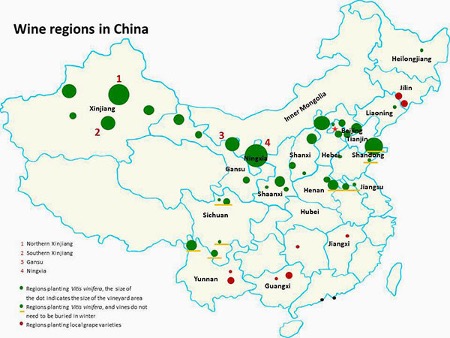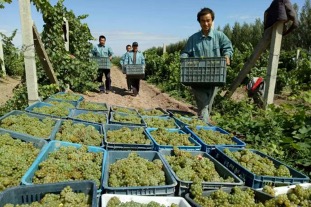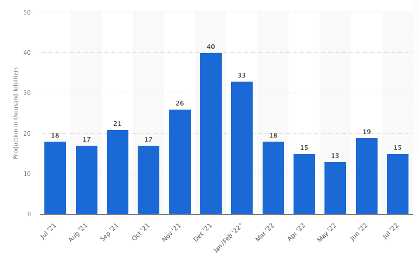As the world’s leading exporter of goods, China is known for producing millions of products we use every single day, from the clothing we wear to essential technical components. But there is one booming industry that you may not associate with China, but you probably should: Wine!
In 2020, China ranked among the top 10 producers of wine in the world. However, it’s the world’s largest grape producer, and houses more land being used for vineyards than any other country! “The Chinese wine industry is booming, as its thirst for wine is outpacing the rest of the world.”
One of the biggest reasons for this increase in wine consumption is how the customer base is evolving. Consumers are becoming younger and younger, as wine moves from the luxury category to an accessible commodity for the middle class. For this younger generation, their preferred method of purchasing wine is online, and their favorite place to import wine from is France.

Map of China showing the development of the Chinese wine consuming market. [Photo Credit: Decanter China]
So, exactly how much wine is China actually consuming? 2013 was a landmark year for the wine industry in China; “it was the first time that the country drank more red by volume than the vin rouge-loving French, beating them by 5 million nine-liter cases, with a total of almost 1.9m bottles.” It is expected that in the next 5 years, consumption of wine in China will rise by one-third to over $23 billion. There has been an 80% increase in the wine market since 2013, and that growth is only just the beginning!
Wine production in China dates back to the Han dynasty (206 BC–220 AD) when grape cultivation was first taking place. For a long time, drinking wine was seen as a status symbol or luxury. Despite the early origins of wine making, it was most notable associated with the Tang Dynasty (618 AD – 907 AD), when “wine-drinking culture accelerated and wine consumption became something that was celebrated in culture, language and the arts.” The first modern winery, however, was created in 1892 by Chinese diplomat Zhang Bishi, who imported grape vines from the U.S. and Europe to open the Changyu Pioneer Wine Company. Today, Changyu is both the oldest and largest winery in all of China.

Employees working at one of China’s many vineyards. [Photo Credit: XUANYAN WINERY]
From 1980 to 2000, the amount of land being used for vineyard cultivation grew tenfold, and once China entered the World Trade Organization (WTO) in 2001, “tariffs on bottled wine fell from 65% to just 14%, and tariffs on bulk wine dropped to just 20%.” For the first time ever, foreign wine producers were able to enter the Chinese market, and rapid growth made the Chinese market very attractive. After this, red French wine became the most popular wine among Chinese consumers.
Today, China boasts one of the most active wine markets across the globe, coming in 8th for production and 5th in consumption. Over 1 million different wines are for sale on the Chinese market, which is 10x more than in the US!

The graph above shows the production of wine in China from July 2021 to July 2022. [Source: Statista]
Some of the wine superstars dominating the industry are Great Wall, Changyu, and Dynasty. The quality of Chinese wine has tremendous potential, with Great Wall’s merlot/cabernet sauvignon blend winning several awards, and Ningxia-based Changyu Pioneer-Moser XV’s Bordeaux being a favorite among wine critics. Edward Ragg, a Master of Wine and co-founder of Beijing-based Dragon Phoenix Wine Consulting said, “I'm sanguine that we will see truly world-class wines produced by China in the next 10-15 years.”
Producing wine in China’s varying climates and terrains, however, is not always an easy feat. In Northern wine regions, vines must be buried through the winter until spring in order to stay alive during extremely cold and dry winters. In Eastern China, the summer rains and humidity lead to fungal diseases on the plants, and in the South, weather temperaments may be preferable, but the high altitude makes production and shipping difficult. Despite these challenges, Ragg says that China has undergone immense progress “in a relatively short period of time compared with the evolution traditional regions have undergone in France, Italy and Spain.”

A Vineyard in China’s wine region. [Photo Credit: Decanter China]
Throughout the pandemic, foreign importers had a tougher time entering the Chinese market, giving domestic brands a chance to seize the market. China imposed tariffs on wine coming from countries like Australia, and the ongoing Trade War meant consumers had to source wine from within their own borders. Shutdowns and quarantines across China made customers look even more locally to source their wine, with consulting firm McKinsey reporting that, “local brands are winning because they better address consumer needs in three areas: value for money, quality and aftersales service."
By 2021, the size of the Chinese wine market was $42 billion. This figure is expected to grow by 11% in the coming 5 years, with the key categories in wine being still wine and sparkling wine. If you plan on taking a trip to China in the coming years, make sure to stop by one of the following cities in order to tour a vineyard and taste test China’s wine offerings for yourself: Chongqing, Shanghai, Beijing, Tianjin, Chengdu, Guangzhou, Baoding, Shenzhen, Shijiazhuang, and Linyi.
If you have not yet tried Chinese wine, make sure to pick up a bottle next time you are in the market to try something new. Doing some research about which region and vineyard the wine originated from is a fun and unique opportunity to support a local community and learn more about Chinese culture!
